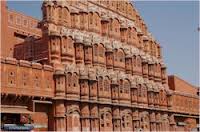History Of Jaipur City
Jaipur, the pink city was founded in 1727 by Maharaja Jai Singh II, a Kachhwaha Rajput, who ruled from 1699-1744. Initially his capital was Amber, which is at a distance of 11kms from Jaipur.
The need to shifting his capital city arose due to the increase in population and growing water problem. Jaipur is the first planned city of India . The King took great interest while designing this city of victory. He consulted several books on architecture and architects before making the lay out of Jaipur. He applied his scientific and cultural interests to make a brilliant city. Jai Singh sou ght advice from a Bengali Scholar,Vidyadhar Bhattacharya, who was a “Shaspati” ie a Hindu Priest architect , to aid him design the city architecture. Vidyadhar referred the ancient Indian literature on astronomy, books of Ptolemy and Euclid, and discussed the plan with the King.
ght advice from a Bengali Scholar,Vidyadhar Bhattacharya, who was a “Shaspati” ie a Hindu Priest architect , to aid him design the city architecture. Vidyadhar referred the ancient Indian literature on astronomy, books of Ptolemy and Euclid, and discussed the plan with the King.
With a strategic plan, the construction of the city started in 1727. It took around 4 years to complete the major palaces, roads and square. Jaipur was built following the principles of Shilpa Shastra, the Indian Architecture. The town of Jaipur is, in fact, built in the form of a nine-part Mandala known as the ‘Pithapada’. Nine signifies the nine planets of the ancient astrological zodiac. It is also known that Sawai Jai Singh II was himself a great astronomer and a town planner and hence the ‘Pithapada’. Also, the commercial shops designed are multiples of nine(27) and then having one cross street for a planet. So also the city was divided into nine blocks, out of which two consisted the state buildings and palaces, whereas the remaining seven blocks were allotted to the public. The central of the seven rectangles comprised the city palace complex, containing the palace itself, the administrative quarters, the Jantar Mantar (The amazing observatory) and the janana mahals (women’s palaces),which housed the many wives of the maharaja.
After many experiences of several battles with Marathas, Jai Singh was keen on the security aspect of the city. Therefore, to ensure the security, Jaipur was encircled by huge fortification walls which opened at seven strong gates.
According to that time and era, architecture of the town was very advanced, scientific and certainly architecturally the best in the Indian subcontinent. In 1853, when Prince of Wales visited Jaipur, the whole city was painted in Pink (the color of Hospitality) to welcome him. Still, the neat and broadly laid-out avenues, painted in pink provide a dreamy charm to the city. Jaipur is rich in its cultural and architectural beauty, which can be traced in the various historical and aesthetic places that form the heart of the city. This city of victory really wins the hearts of the people with its charm and hospitality.
